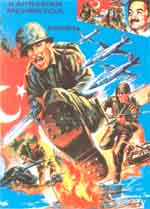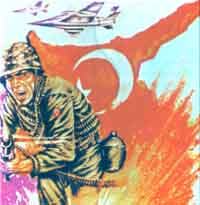CYPRUS - 1974 - PHOTO ARCHIVE
[Main Page][Turkish Invasion][Missings][Refugees][Greek Orthodox Churches/ Monasteries][Villages/Towns][Castles/Ancient Greek sites][Cultural Destruction][Forged Greek names][Links][Ελληνική Έκδοση]
1974 Turkish Invasion Against CYPRUS
-July 20, 1974-
Time: 04:35, Saturday 20 July 1974. The graphic and most beautiful ancient Greek town of Kyrenia as it was seen by the Turkish pilots the morning of 20 July 1974 when the air-raids of the Turkish air-force against Cyprus began. Bombings were more intense on the northern shores of Cyprus and around the "Pente Mili" (five miles west of the town of Kyrenia) area where all the landings took place. Click the photo for enlargement.























